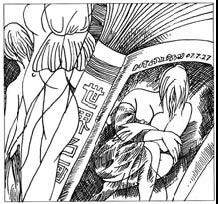Drawing the line between art and porn
Updated: 2007-07-27 06:44
How to define art and pornography is at the center of a debate heating up after the Hong Kong Television and Entertainment Licensing Authority (TELA), the government's decency watchdog, asked a publisher at a book fair last week to withdraw a work containing paintings of nudes.
 It is not clear whether or not the TELA knew the paintings, mainly depictions of Western myths, were among the collections of celebrated museums around the world, such as the Louvre in France, but it took back its "advice" after the episode came under the public glare the following day.
It is not clear whether or not the TELA knew the paintings, mainly depictions of Western myths, were among the collections of celebrated museums around the world, such as the Louvre in France, but it took back its "advice" after the episode came under the public glare the following day.
This is not the first time there has been controversy in Hong Kong caused by confusion over the delicate line between art and obscenity.
In 1995, the TELA referred a picture of the completely naked statue of David, which was on public display, to the Obscene Articles Tribunal (OAT). The tribunal, which comprises a presiding magistrate and two adjudicators, ruled the statue of David was "obscene". The case went all the way to the High Court where the "obscene" ruling was ultimately overturned.
It must be pointed out that the TELA and the OAT usually act on complaints made by members of the public. Moreover, they pledge to follow closely standards for taste and decency accepted by the community and reflect them in their decision.
Not everyone in the community feels the same, however. What is artistic to some might be perceived as offensive to others.
So, what is art? And how is it different from pornography?
Dictionaries come in handy when we try to draw this line.
According to the Merriam-Webster dictionary, a work of art is something that gives aesthetic satisfaction and sensational feelings to the viewer or listener. The New Oxford Dictionary of English defines art as, "the expression or application of human creative skill and imagination ... producing works to be appreciated primarily for their beauty or emotional power".
The online encyclopedia Wikipedia says a work of art stimulates not only the human senses but also the human mind and spirit.
As for "pornography", the Oxford Dictionary describes it as being "intended to stimulate erotic rather than aesthetic or emotional feelings". That is to say, "art" conveys "beauty" and "pornography" generates erotic stimulation. But the definition of "beauty" can be as evasive as "art".
It can mean different things to different people. A picture might look "beautiful" to the trained eye but incomprehensible to the novice, especially when it comes to abstract art. Not everybody is able to admire Picasso's paintings, for example.
That a modern and cosmopolitan city like Hong Kong could have such a divergence of opinions over what is "art" and what is "pornography" is probably because the city is a place where Eastern and Western cultures meet. Liberal and conservative ideas about sex coexist in the same society.
It is a healthy phenomenon to have such differing ideas over various concepts. The more people argue about anything, the more they will come to understand the matter of contention, as long as the debate is conducted in a rational manner. That is not to say there is no principle to go by. There is the law - the obscene and indecent articles ordinance, for instance - to resort to. And there is the mainstream opinion.
What these institutions should do is not only look up the relevant legal provisions, but also hold public forums to gauge the prevailing aesthetic and moral standards in the community.
There is, however, one simpler and more convenient way to handle this issue - if something has already been classified as a piece of art by centuries of art critics, it is most probably not a work of pornography.
E-mail: zouhr@chinadaily.com.hk
(China Daily 07/27/2007 page10)
|
|
|
|
|
|